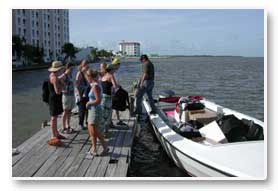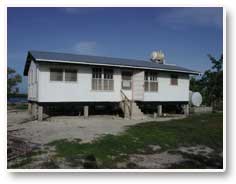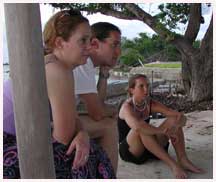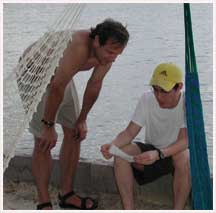

Wednesday, August 28, 2002
![]()
The plane lands, the door opens, and once again, we step out into the tropics. A rush of hot, heavy, sweet smelling air surrounds us completely. Walking down the stairs and onto the tarmac leaves us drenched in sweat.
 And
so begins our expedition to Belize—our fourth Virtual Explorers expedition.
After months of planning and preparation we are finally here and it feels
good. Immediately and without thinking, we begin to notice what is familiar
and what is new and strange to us. We watch everything out the taxi window
as it winds its way through the streets of Belize City. It is what is foreign
and strange that makes traveling both so rewarding and challenging at the
same time. Being confronted with “newness” is what forces us as
travelers to expand the parameters of what we know and understand about
the world and ourselves. It feels great to be back out in the world again!
And
so begins our expedition to Belize—our fourth Virtual Explorers expedition.
After months of planning and preparation we are finally here and it feels
good. Immediately and without thinking, we begin to notice what is familiar
and what is new and strange to us. We watch everything out the taxi window
as it winds its way through the streets of Belize City. It is what is foreign
and strange that makes traveling both so rewarding and challenging at the
same time. Being confronted with “newness” is what forces us as
travelers to expand the parameters of what we know and understand about
the world and ourselves. It feels great to be back out in the world again!
As previously arranged, the team met Katie, Caryn, and their two interns,
Tami, and Hannah at the Princess Dock in Belize City in the afternoon. While we were
flying in from different cities, Katie and Caryn spent the day shopping
for the supplies that we will need for the next week—bags of oranges,
flats of eggs, 5 lbs of brown sugar, 5 lbs of cheese, chickens, 10 lbs of
flour, and crates of fresh produce. When we arrived they were already loading
the speed boat that will carry us out to the research base.
Hannah at the Princess Dock in Belize City in the afternoon. While we were
flying in from different cities, Katie and Caryn spent the day shopping
for the supplies that we will need for the next week—bags of oranges,
flats of eggs, 5 lbs of brown sugar, 5 lbs of cheese, chickens, 10 lbs of
flour, and crates of fresh produce. When we arrived they were already loading
the speed boat that will carry us out to the research base.
We introduced ourselves and boarded the boat ready to spend the next two
weeks together on a very small island. No doubt everyone was excited and
a little apprehensive about what the next two weeks would bring. The good
news is that, at least for the next week, there are no tropical storms brewing
offshore.
A thirty-minute ride and we were at Spanish Bay Research Camp—home
for the next two weeks. This side of the island holds two buildings—a
dormitory and a kitchen. The building materials for both buildings are mostly
recycled from Belize City. The  dormitory
has four small rooms and a bathroom. The dorm rooms have only walls with
no ceilings so that we really are all sleeping in one large room with partitions.
For us though, this is luxury accommodation compared to what we had in both
Ghana and the Amazon. All but Caryn sleep in the dorm. When we have all
gone to bed, Caryn hangs a hammock in the kitchen.
dormitory
has four small rooms and a bathroom. The dorm rooms have only walls with
no ceilings so that we really are all sleeping in one large room with partitions.
For us though, this is luxury accommodation compared to what we had in both
Ghana and the Amazon. All but Caryn sleep in the dorm. When we have all
gone to bed, Caryn hangs a hammock in the kitchen.
Flush toilets! Yes, we have them—two toilets to be exact. We are thrilled
not to have to make our way at night through the jungle to the outhouse.
Then using our flashlights, scan the inside of the outhouse to ensure that
there are no deadly snakes before stepping inside to relieve ourselves.
Going to the bathroom in the middle of the night will be a cakewalk.
While this is more than adequate for our needs for the time we are here,
Caryn told us that this side of the island couldn’t sustain this many
people for much longer than two weeks.
 As
the sun was setting and the lights of Belize City began to shine on the
horizon, we sat under the palapa, the thatched sun shelter, and each person
told a little about themselves. A cool breeze blew over the island—a
relief from the heat of the day and a bit of a defense from the relentless
sand flies.
As
the sun was setting and the lights of Belize City began to shine on the
horizon, we sat under the palapa, the thatched sun shelter, and each person
told a little about themselves. A cool breeze blew over the island—a
relief from the heat of the day and a bit of a defense from the relentless
sand flies.
Katie and Cary met 3.5 years ago while in the field. They
discovered that they both had the same goals in establishing a long-term
research project. More, they had the same philosophy about conducting research
in developing countries. It was important for their individual research
that their topics overlapped but with different emphasis. Caryn is focusing
on animal behavior, in particular how manatees use sound and Katie is studying
how manatees use their habitat, in particular the seagrass beds. Together,
along with other sirenian researchers, they formed Sirenian International
in 2000. Sirenian International, Inc. is a nonprofit organization that funds
and supports sirenian research around the world. You may want to read the
background information about sirenians to learn more about these gentle
creatures. 
 Katie
just took her written exams and will take her oral exams in October for
her doctorate. She also had a baby last January. Drew is six months old.
Katie of course had pictures that she shared with us. Caryn told us that
her dream had always been to go to college. When her youngest daughter decided
to go to college Caryn decided it was time. She actually started the same
year as her daughter! After receiving her bachelors degree, she loved what
she was studying and decided to continue with her doctorate.
Katie
just took her written exams and will take her oral exams in October for
her doctorate. She also had a baby last January. Drew is six months old.
Katie of course had pictures that she shared with us. Caryn told us that
her dream had always been to go to college. When her youngest daughter decided
to go to college Caryn decided it was time. She actually started the same
year as her daughter! After receiving her bachelors degree, she loved what
she was studying and decided to continue with her doctorate.
 Caryn
has been here since June. This is the first time Katie has been here this
season because of her new baby. She will spend only the first week with
us and then return home. This is the first time that researchers have had
the opportunity to study a population of manatees in their native environment
outside of Florida.
Caryn
has been here since June. This is the first time Katie has been here this
season because of her new baby. She will spend only the first week with
us and then return home. This is the first time that researchers have had
the opportunity to study a population of manatees in their native environment
outside of Florida.
Island Living
Water—we are surrounded by it but it is very much a luxury here. Our
drinking water is rainwater gathered in a 1000-gallon tank that is pumped up to a holding tank on top of the dorm. It is then
fed to the camp by gravity. The toilets are flushed with salt water that
is pumped with a bilge pump powered by a solar panel. Water for drinking
is filtered with a very fine filter to protect us against potentially harmful
organisms. However, it takes all day to fill a five-gallon jug because it
drips so slowly!
tank that is pumped up to a holding tank on top of the dorm. It is then
fed to the camp by gravity. The toilets are flushed with salt water that
is pumped with a bilge pump powered by a solar panel. Water for drinking
is filtered with a very fine filter to protect us against potentially harmful
organisms. However, it takes all day to fill a five-gallon jug because it
drips so slowly!
 We
do have lights! They are powered by solar panels and a wind generator that
whirs constantly. There is a gasoline-powered generator but it only runs
a few hours a day and powers only the refrigerator.
We
do have lights! They are powered by solar panels and a wind generator that
whirs constantly. There is a gasoline-powered generator but it only runs
a few hours a day and powers only the refrigerator.
The toilets flush into a septic system but with the water table so high
and high tide regularly flooding this portion of the island, we can’t
put any paper into the toilet. All of that gets put in a box beside the
toilet and then burned twice a week along with all other burnable trash.
There is little recycling in Belize so Katie and Caryn are very careful
about not generating too much trash. All non-burnable trash is taken off
the island except tin cans. They are taken to the other side island and
used for landfill. Most of Belize City was created this way. People put
items like cans and bottles into the shallow water and then cover them with
dirt. This then becomes new areas on which to build homes and businesses.
We go to bed with the sounds of each other’s sleep noises in our roomy
bunkhouse and eagerly wait for dawn. Tomorrow we get into the boat and explore
the water for the first time! We are all hoping for a manatee sighting!
![]()